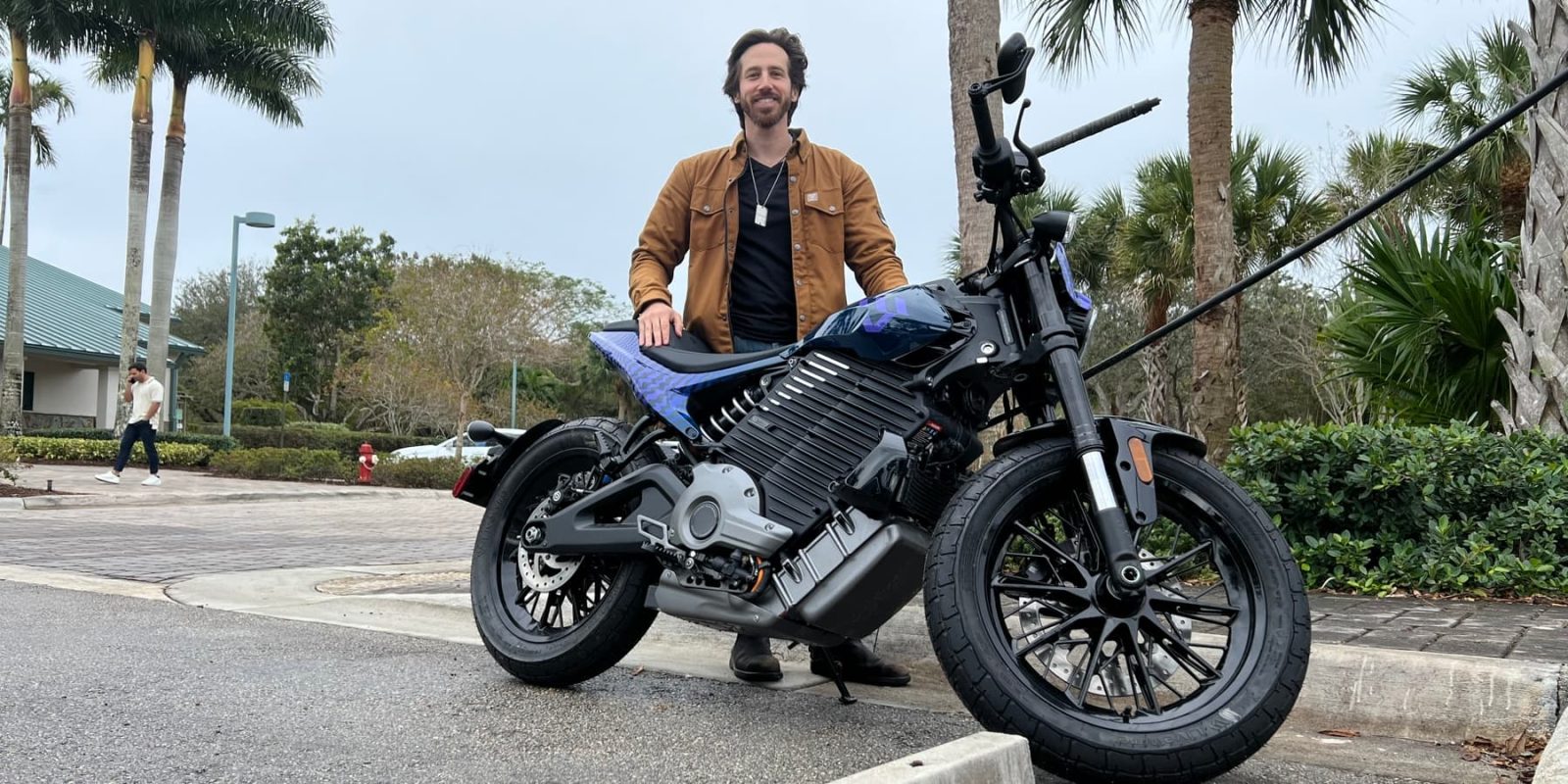
LiveWire, the all-electric motorcycle brand spun out of Harley-Davidson, is shaping itself into a force to be reckoned with in the still-evolving electric motorcycle industry. The company brings an interesting mix of high-tech startup energy and a lumbering century-old motorcycle legacy that results in both an impressive (and growing) range of electric motorcycles but also a series of growing pains. And I got to experience all of it as the proud new owner of a shiny indigo LiveWire S2 Del Mar Launch Edition electric motorcycle.
To properly tell the story though, we’ve got to briefly back up a few years. Actually, about a decade. It was the early 2010s and almost no one outside of Zero Motorcycles was putting real thought into electric motorcycles – least of which the legacy motorcycle manufacturers. But somehow, and against all odds, the stereotypically old-fashioned motorcycle behemoth Harley-Davidson had already realized that electric was the future, even if it was a distant one. And so the company started Project LiveWire. It would take nearly five years from the first prototype rolling out in 2014 until the bike began deliveries in 2019, but the resulting Harley-Davidson LiveWire was widely regarded as an impressive and high-performance electric motorcycle. It also carried an equally high price tag of nearly $30k.
But just because the big wigs at H-D recognized that electric motorcycles would eventually become the norm and that it was better to get in early, H-D riders didn’t quite get the memo. The high price tag combined with the Harley branding meant that the market was limited mainly to wealthy, older brand loyalists, and they weren’t exactly buying it by the thousands. The bike certainly still brought in newcomers, but not the wave of young urban riders that H-D had hoped for.
So the company called an audible, and in a move that is likely still too recent to be effectively judged through the lens of hindsight, Harley spun out all of its electric motorcycle development and sales into a new brand known as LiveWire. The original motorcycle was relaunched as the LiveWire One, also shaving around $7,000 off the price tag to under $23k. Still expensive, but in line with plenty of high-end motorcycles from all the major players in the industry.
But the real electric treasure was yet to come: a new model on an entirely novel platform: the LiveWire S2 Del Mar. Priced at around $15k and sporting a more urban-friendly design, this was the bike that could really hope to snag that new wave of riders – and it worked on me.
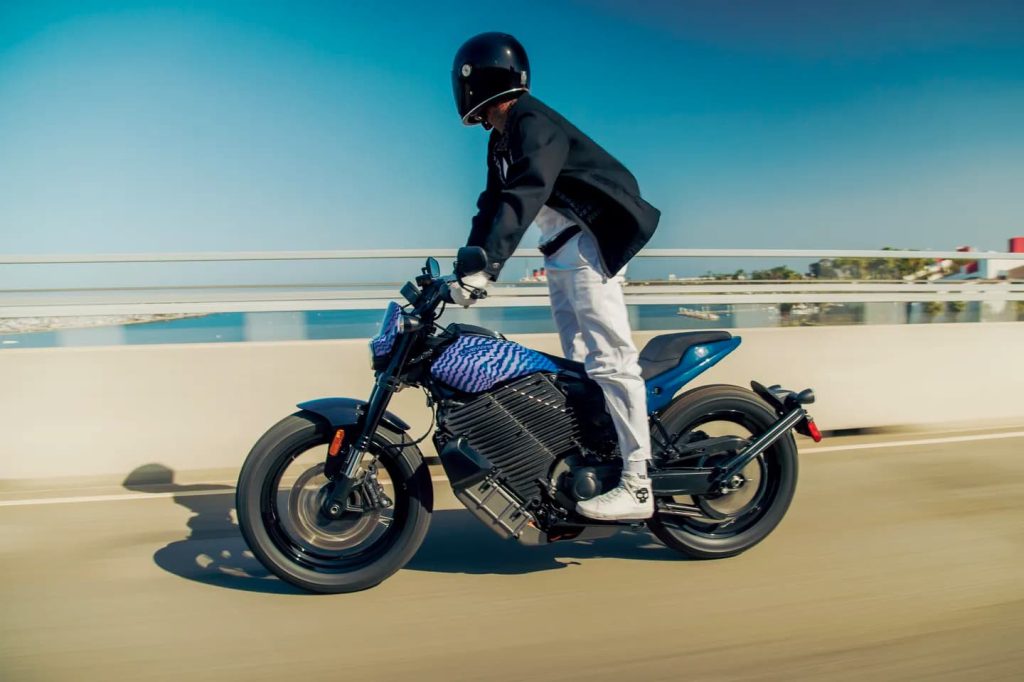
In fact, I was one of the first people outside of the company to test ride the bike, giving an S2 Del Mar production prototype its first press ride, cruising New York and New Jersey flanked by two LiveWire team members on equally impressive LiveWire Ones.
In many ways I was exactly the target market, a younger and more urban rider that was drawn not by the brand as much as by the bike itself. The last time I was on a Harley was the day I passed my motorcycle license exam in a Harley dealership parking lot. And even then it was a Street 500 – basically an entry-level baby Harley by pretty much anyone’s standards. I’ve been almost exclusively electric ever since, outside of occasional jaunts on borrowed gas bikes that has inadvertently reminded me each time why I went electric in the first place. I’m not touring across the country – I’m riding through the city and occasionally the countryside, rarely more than 40-50 miles from an electrical outlet. There are long-range e-motos out there if I ever wanted to tour (and plenty of people have done cross-country rides on LiveWire Ones), but I’m the quintessential young urban rider just looking to have the type of fun that doesn’t require 300 miles in a day.
And so as soon as I finished my first-ever test ride on that LiveWire S2 Del Mar production prototype in late 2022, I pretty much knew I’d want to buy it. It took a while – as many new EVs do – but it finally launched and I managed to snag a Launch Edition of the bike, of which only 100 were built for North America. And that’s where things got really interesting.
To be fair, I made things even more complicated because I don’t live in North America. I’m in the US much of the year, and was buying this bike as my local wheels in the country, but I had to purchase it from 6,000 miles away. Fortunately, LiveWire operates like a young and agile startup, meaning buying one online wasn’t that much harder than shopping on Amazon.
The actual hard part, I would soon learn, would be the delivery. And that’s where things got really interesting. LiveWire’s image of a hungry young motorcycle startup is so perfectly contrasted by Harley-Davidson’s legacy status as a lumbering, slow-to-change behemoth of the industry that you couldn’t write a better divergence if you tried. And as much as LiveWire’s marketing department tries to distance itself from its boomer parents, its logistics department still kind of needs to live at home, so to speak.
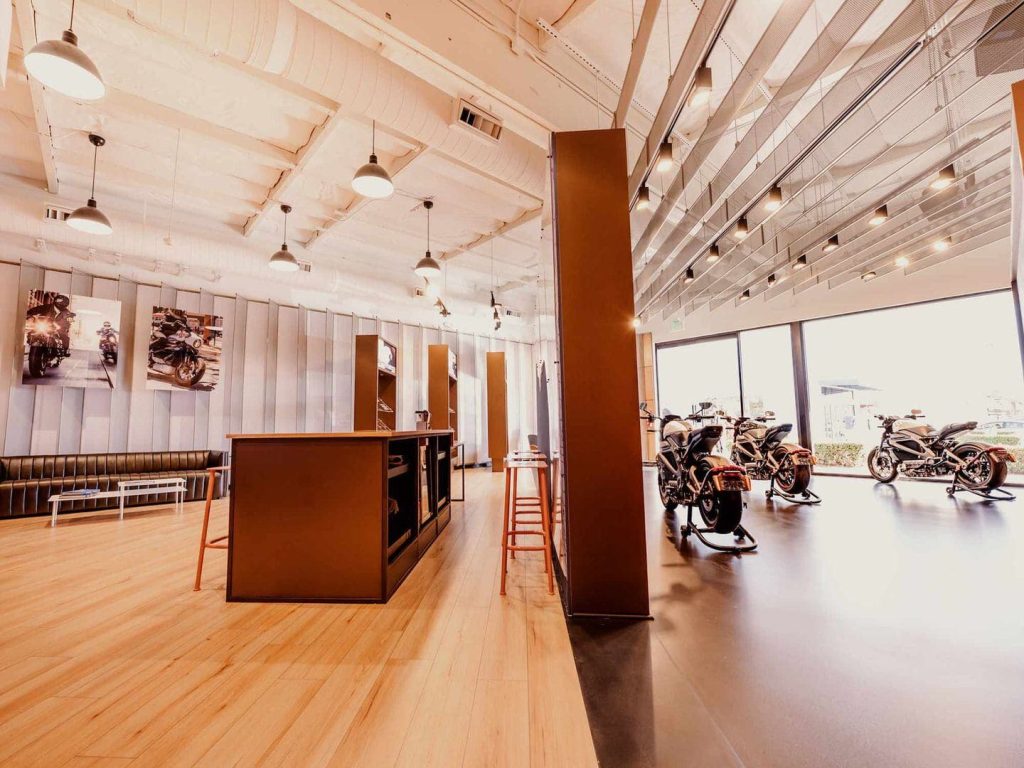
LiveWire does have its own stores, and I once visited the LiveWire Experience Center in Malibu to find something that feels like a motorcycle shop meets an Apple Store, with a bit of Urban Outfitters thrown in for good measure. But there are hundreds more H-D dealers, each of which can serve as a potential forward operating base for LiveWire (a major advantage over every other electric motorcycle company). And I discovered this first hand when I showed up for my delivery appointment at “LiveWire Sunrise” in Sunrise, Florida, earlier this week, only to discover that it was actually a Harley-Davidson Dealership that happened to have a half-dozen LiveWire bikes.
“Ok, that’s fine” I thought as I walked in the front doors. In fact, it’s kind of perfect. H-D dealerships have large service centers and plenty of parts availability. All the better for me. But things soon got weird. I introduced myself to the nice woman manning the front desk. “Hi, I’m Micah. I’m here for my LiveWire pickup appointment,” I excitedly explained. “Cool,” came the response. “You’re here for what?”
Apparently, I had surprised them. No matter that I had paid LiveWire for the bike a couple months ago and by all accounts LiveWire had sent my new bike to the dealership six weeks ago. I got passed around first to the service area, then to the business area, each person trying to figure out who I was and why I was there. They were all exceedingly friendly, but none of us knew where my bike was or that I had even bought one. And I was apparently the only one who thought I was supposed to pick it up there that morning.
I sent a couple quick text messages to a few LiveWire hotshots (millennials, amiright?) and things were suddenly starting to get sorted out. It turns out my bike was there, and they found it upstairs. Except it had been sitting there with 0% charge. A string of very nice and apologetic Harley employees all rushed into action, trying to throw together a delivery ceremony that is normally a highly orchestrated operation but was complicated by the fact that this time it involved a bike that they didn’t understand and didn’t know they even had in their possession – or that they’d be delivering today.

They rolled my bike into the service department and got it on a 120 VAC wall charger, pumping 1.4 kW of power into its 10.5 kWh battery. For the uninitiated, that’s a roughly 8-9 hour charge. That’s also why charging from a traditional 120 VAC wall outlet is usually reserved for overnight charges. Just to add a little stress on top of this whole situation, there was also the small wrinkle of me needing to be in a meeting in two hours and then head to the airport in another two hours. And I still had 30 miles to ride this bike home. This was going to be interesting.
Again, the Harley folks were kind and helpful to a fault, but I had to explain to them the difference between Level 1 charging (slow wall outlet) and Level 2 charging (faster public charging stations), and why the first was going to have us organizing a slumber party in their service department later that evening.
One tried to be helpful and suggested the DC Fast Charger out front, but before I could start to explain why that wouldn’t work (the S2 Del Mar doesn’t have DC Fast Charging like the LiveWire One), another employee piped up and reported that the dealership had recently decommissioned its DC Fast Charger. Whoops.

At this point, it was pretty clear that I was going to be responsible for sorting this pickle out, and a quick look on my phone’s map showed me that there was a Chargepoint station down the road. So I decided to just let the wall outlet pump as much charge in as I felt comfortable with to get me down the road. In the meantime, the Harley folks gave me the grand tour, showing me around a massive service department, followed by a trip into the catacombs of the building where hundreds of bikes were stored, many dating back decades and each with their own colorful stories. I can see how this would have been a trip to motorcycle Mecca for diehard Harley fans, but I was here for one very specific, very electric LiveWire.
After the tour and once I had around 15% charge into the bike, they had me sign a few forms and then slapped a paper license plate on the back of my bike while I got my gear ready. Part of the handoff included a big briefcase with my new wall charger in it, but my little camera backpack wasn’t having any of that. So I just tied the charger briefcase onto my backpack and I was ready to roll down the road after a quick bell-ringing ceremony.
As a side note, the bell-ringing ceremony was actually really cool and drove home the “Now you’re family” line that I heard at least a dozen times during my 90 minutes or so at the dealership. Even though my bike doesn’t look like a traditional Harley, there were dudes in H-D leathers coming up to shake my hand and congratulate me on the new bike, accepting me into the family. For all the crap they get about stereotypes, all the Harley people I’ve actually met in real life are nice, welcoming people.

This was also a great chance for me to test out my new Beyond Riders canvas shirt – a protected riding shirt that has Level 2 armor yet doesn’t look like a typical sporty or bulky riding jacket.
There are times I’m heading out with my wife and don’t want to look like I just got back from canyon carving, so this seemed like it would be ideal for my casual city riding. And the fact that it has full armor inside means that I can stay protected without looking super geared up.
There’s also all sorts of hidden features inside that I’m still discovering. I’ll have a more complete review of the couple Beyond Riders jackets I recently got, but that’s coming soon. For now, let’s ride!
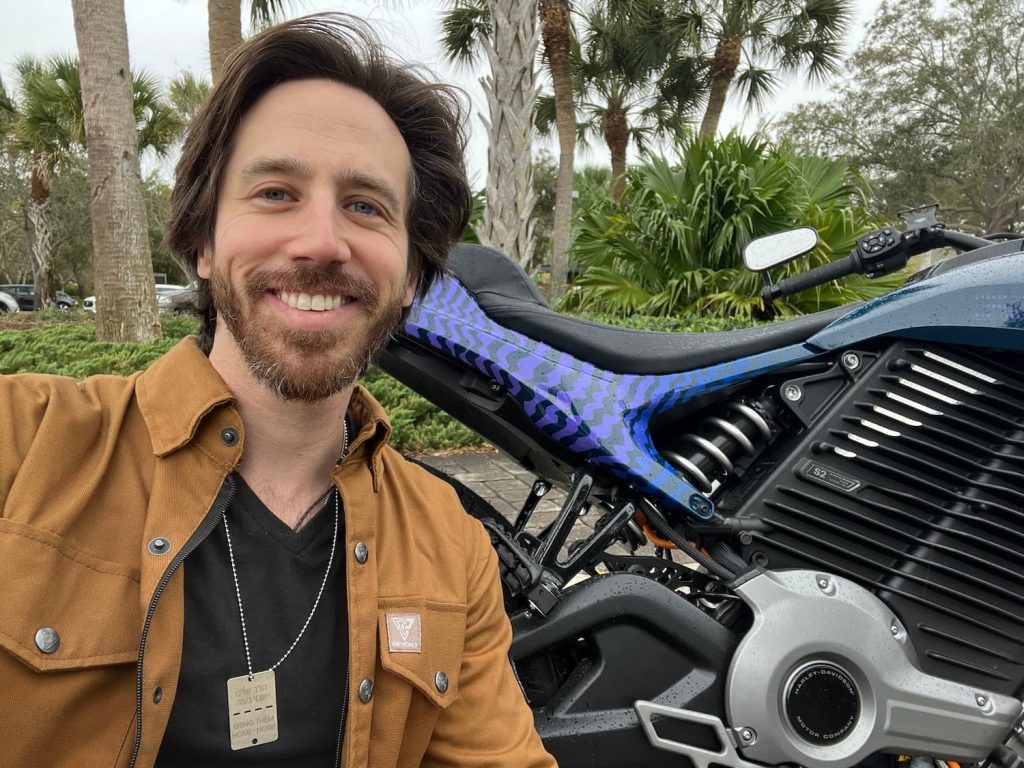
So there I was, on the open road – if only briefly. I made it to the Level 2 charger near the dealership and started pouring in the electrons as quickly as the 5.5 kW connection would allow. I had an Electrek team call to make it on to and so I hopped on the road after 30 minutes or so of charging, having gotten me up to around 40%, including a bit of the slower charging at the dealership. Interestingly, my charging bill was just $0.19. Sure, it was just under a “half tank”, but still. Do you know how much gasoline 19 cents will buy you? A tea cup’s worth. Seriously, I did the math.
From there, I thought I would have enough for the 30-mile ride home, and what a ride it was! I started with mostly highway riding, and it was exhilarating! Florida highways aren’t exactly prime riding locations, but it was still a blast. The LiveWire Del Mar can hang on the highway or even the track, touting a top speed of 103 mph (165 km/h) – not that I will ever need it to go that fast.
But the max range of 113 miles (182 km) is also the city range, so you’ll ding that number by spending all your miles at highway speeds. And that is exactly what I was doing.
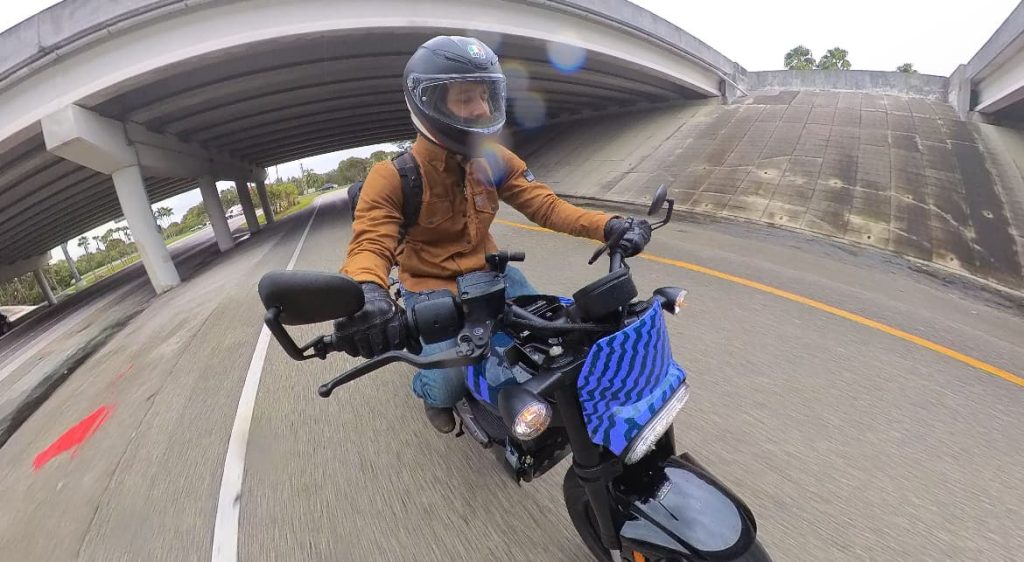
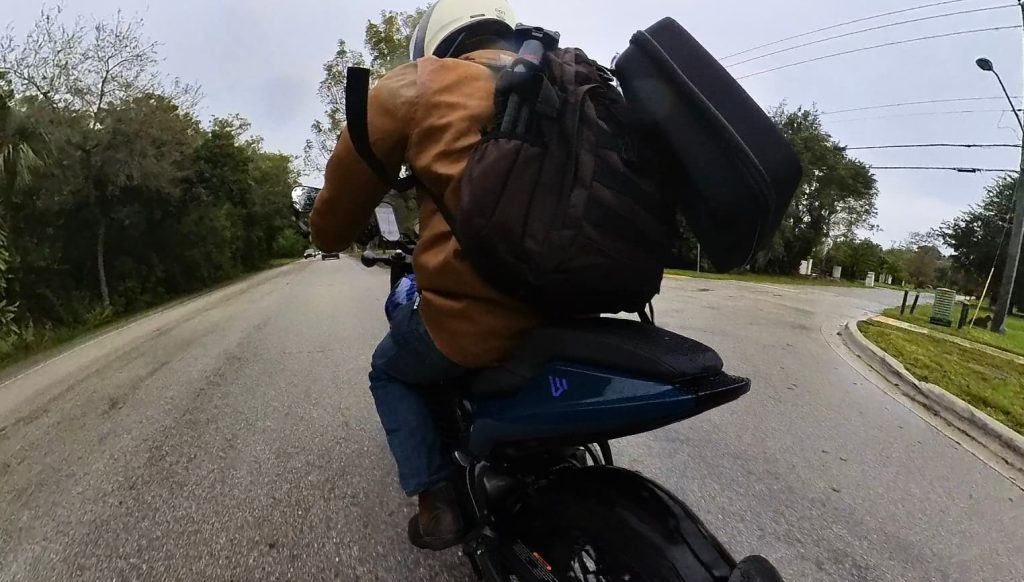
Unfortunately, I was having too much fun and going way too fast, so my battery was dropping quickly and I could tell I wouldn’t make it all the way home with just the bit of charge I had gotten into the bike. So I set my GPS for the nearest charging station, quickly discovering that my phone was also running on the digital equivalent of fumes. The GPS combined with the cool air at highway speeds was eating into my handlebar-mounted phone’s battery quickly, which left me with a Catch-22. I could ride more slowly to save motorcycle battery, but if it takes too long and my phone dies en route, then I wouldn’t be able to start the app-based charger when I got there. Or I could ride faster to arrive before my phone died, but then I might burn too much motorcycle battery and not even make it.
Oh, and did I mention that it’s been raining off and on again this entire time?
This range issue wouldn’t usually be a problem if I had started the day with a fully charged battery instead of a 0% charged battery, mind you. So don’t get the wrong impression here. The bike has the power and the range for anything I need, just not when you forget to charge it up before the customer arrives to ride it home.

So I split the difference on speed and rolled in with 8% charge on my bike and even less on my phone. But I made it. I plugged in the bike, then fished around in my bag for a portable phone charger and plugged that in too, before hopping onto my Zoom meeting by phone fashionably late and in the parking lot of the local public library.
The rest of my 45-minute meeting pumped my bike’s battery up to around 50% charge. It was also free, weirdly enough. You gotta love free public chargers!
The rest of the ride home was back on the highway followed by final city riding, rolling in with around 36% charge left.
The mix of highway and city riding is basically the exact scenario this bike is meant for. It’s got crazy power when you need it but can also cruise for hours and hours at city speeds.
The bike is also smaller and more comfortable than the LiveWire One, at least in my opinion. It’s nearly as powerful, and just a tenth of a second slower than the LiveWire One’s 0-60 mph time of 3.0 seconds. It puts me in a much more upright and comfortable riding position than the LiveWire One’s longer reach, and while it isn’t a cruiser, it definitely gives me roadster vibes in a street-oriented flat tracker design.
Top comment by Renaissance
Pretty weird if the factory even sent out a bike with 0% charge, as that's impractical and bad for the battery cells. And I can't imagine anyone at the shop was taking joy rides on your new bike. Some sort of vampiric battery drain issue that needs to be solved with a software update, perhaps?
Basically, it’s the urban commuter that LiveWire always should have built, yet with enough speed and power to cover higher-performance riding. And with a 10.5 kWh battery, it’s got the range that most city riders need. 113 miles (182 km) is enough for me. Again, I definitely won’t be touring on this bike, but I can also basically treat Level 2 car chargers like fast chargers, since just over an hour of charge will refill the majority of my battery. It’s not a 30-minute DC Fast Charge, but I also don’t need a 30-minute charge. Stopping for lunch while mostly refilling my battery is good enough for me, since most of my rides are across town and fun beach road cruises.

Of course having only spent my first afternoon on the bike, I don’t yet have the weeks of range experience to dive into the weeds, at least not yet. But you better believe that’s coming as I put more miles on the bike, and I’ll be excited to share more with you all here.
But as it stands now, the only way forward is up. Sure, delivery was a hot mess of an experience. The LiveWire folks were visibly irritated that the ball had been dropped (and with a journalist, no less), but the good news is that the bike is so incredibly awesome to ride that I can easily look past an H-D dealership full of well-meaning but largely ignorant lifelong riders that are still learning on the job when it comes to EVs. And I get it, this is new stuff. The important thing is that everyone wants to learn. We’re all ignorant in the beginning, and there are definitely growing pains in this progress as LiveWire and H-D continue to smooth out their cooperation.
But one thing I can tell you for sure: As much of a cluster fudge as this was, it was a cakewalk compared to what happened when I recently tried to buy a Honda Motocompacto electric scooter from a Honda dealership – a scooter I paid for last November and have yet to see. But that’s another story for another day…
FTC: We use income earning auto affiliate links. More.



Comments